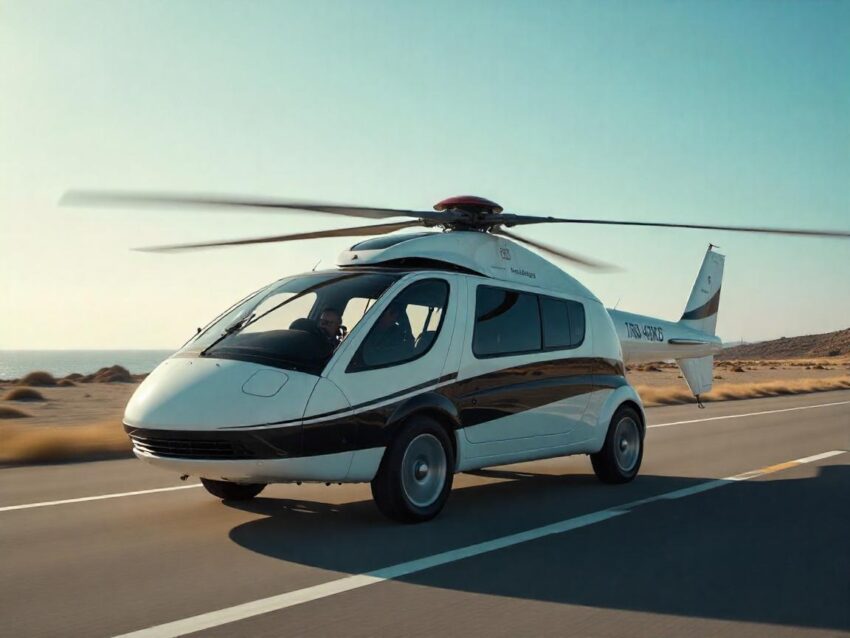US Set to Join Canada, Mexico, India with Electric Air Taxi Travel Revolution

The US is set to join an elite group of nations—China, Germany, France, Japan, South Korea, UAE, Brazil, Australia, UK, Netherlands, Norway, Singapore, India, Canada, Italy, New Zealand, Saudi Arabia, Spain, and Sweden—in advancing the much-anticipated electric air taxi revolution.
As electric aviation technology accelerates and infrastructure plans mature, the US now positions itself to join global leaders in transforming urban and regional mobility through electric air taxis. This sweeping shift promises not only to reduce traffic congestion but to drastically cut carbon emissions in some of the world’s most densely populated urban environments.
The Electric Air Taxi Revolution is no longer a distant dream; it’s unfolding across these innovation-forward nations. From China’s certified autonomous aircraft to Germany’s Volocopter, from France’s Olympic-ready air routes to Japan’s Osaka World Expo plans—each of these countries is pushing boundaries. Now, the US is set to join this cohort, not just by ambition, but by active development, policy alignment, and corporate investments. American companies like Archer Aviation, Joby, and Boeing-backed Wisk are spearheading the nation’s foray into this airborne future, while the FAA moves toward regulatory frameworks that would finally lift these aircraft into commercial reality.
For the latest travel news, travel updates and travel deals, airline news, cruise news, technology updates, travel alerts, weather reports, insider insights, exclusive interviews, subscribe now to the daily TTW newsletter.
In 2025, with infrastructure, innovation, and international momentum aligned, the US, along with China, Germany, France, Japan, South Korea, UAE, Brazil, Australia, UK, Netherlands, Norway, Singapore, India, Canada, Italy, New Zealand, Saudi Arabia, Spain, and Sweden, signals that the global Electric Air Taxi Revolution has reached critical altitude—and the latest update is, the skies are about to change forever.
In the not-so-distant past, the idea of electric air taxis zipping above cityscapes seemed like something straight out of a sci-fi movie. Today, it’s fast becoming reality. The combination of clean energy innovation, urban congestion, and the global climate emergency has fueled the rapid rise of electric vertical takeoff and landing (eVTOL) aircraft. These futuristic vehicles—capable of quiet, zero-emission flights—promise to redefine urban and regional mobility.
With cities around the world struggling to balance economic growth with sustainable infrastructure, eVTOLs are emerging as a revolutionary alternative to ground-based transport. From the skyscrapers of New York and the bustling tech centers of Bangalore to the Olympic skyline of Paris and the futuristic landscapes of Dubai, nations are racing to become early adopters of this airborne innovation. Let’s explore the global rollout of electric air taxis and the countries leading this skyward shift.

United States: The Pioneer in Urban Air Mobility
The United States is leading the global push for electric air taxis, thanks to strong support from the Federal Aviation Administration (FAA), NASA, and major private investors. California-based companies like Joby Aviation, Archer Aviation, and Wisk Aero (a Boeing-backed firm) are conducting extensive test flights and working toward FAA certification.
Archer and United Airlines have announced plans to launch electric air taxi services between Manhattan and JFK Airport as early as 2025. Joby, meanwhile, has partnered with Delta Air Lines for services in New York and Los Angeles. With a favorable regulatory environment, robust funding, and top-tier talent, the U.S. is poised to become the global hub of eVTOL deployment.
Electric air taxis may not be cleared for takeoff just yet, but that isn’t stopping Archer Aviation from laying the groundwork for its urban flight network. The California-based eVTOL (electric vertical takeoff and landing) pioneer has revealed its planned air taxi routes across New York City, setting its sights on drastically reducing travel times between Manhattan and the city’s three major airports.
Archer’s service blueprint would connect the East 34th Street Heliport, Downtown Manhattan Heliport, and West 30th Street Heliport with John F. Kennedy (JFK), LaGuardia (LGA), and Newark Liberty (EWR) airports. The goal is to shuttle passengers between downtown and airport terminals in just 5 to 15 minutes—a fraction of the time it typically takes via ground transportation.
The company’s flagship aircraft, the Midnight, is a four-passenger, human-piloted eVTOL vehicle designed specifically for short urban flights. Once operational, these flying taxis are expected to cruise between 2,000 and 3,000 feet above ground, staying well clear of commercial jet traffic while offering a quicker, quieter, and emissions-free alternative to congested roadways.
However, Archer’s plans remain grounded—at least for now. The company, like all others in the advanced air mobility (AAM) space, is still awaiting formal clearance from the Federal Aviation Administration (FAA). The regulatory body has yet to finalize how eVTOLs will be integrated into the nation’s airspace, particularly in busy metropolitan regions like New York.
The FAA’s considerations include defining flight corridors, pilot qualifications, vertiport operations, and coordination with existing aviation traffic. Though Archer had hoped for regulatory approval by the end of last year, delays have persisted into 2025. Despite the holdup, industry insiders remain optimistic that approval is imminent.
Archer’s progress comes as major airlines bet big on the future of air taxis. United Airlines placed a deposit in 2022 for 200 of Archer’s Midnight aircraft, underscoring its intent to lead the charge in urban aerial mobility. Not to be outdone, Delta Air Lines has invested in rival Joby Aviation, another U.S. eVTOL manufacturer vying for a share of the fast-approaching market.
While Archer has yet to confirm how many daily flights it will operate or what hours the service will run, its advance planning signals growing confidence in the sector. As FAA certification edges closer, the skies above New York may soon host a new class of commuter—soaring quietly above traffic, battery-powered and bound for the gate in minutes.

Germany: Engineering Precision Meets Aviation Innovation
Germany has emerged as Europe’s leading eVTOL hub. Two companies—Volocopter and Lilium—are spearheading development, and both are in advanced stages of certification with the European Union Aviation Safety Agency (EASA).
Volocopter is preparing to launch commercial services in Paris in time for the 2024 Summer Olympics, while Lilium’s jet-powered eVTOL targets regional travel between cities across Europe. German infrastructure is also adapting to support this shift, with airports like Frankfurt and Munich exploring vertiport integration and airspace management solutions.
France: Paris Prepares for Olympic-Grade Air Taxis
Paris is preparing to become the first European city to launch commercial eVTOL services, with test flights already taking place. Partnering with Groupe ADP and Volocopter, French authorities are building vertiports in the Paris region to connect airports and major urban centers during the 2024 Olympics.
The French government has streamlined airspace approvals, signaling a strong institutional commitment to urban air mobility (UAM). The capital’s ambitious approach could set a blueprint for other European cities to follow.
Japan: Olympic Dreams Extend to the Skies
Japan has embraced electric air taxis as part of its broader strategy for smart city development. SkyDrive, backed by Suzuki, plans to debut eVTOL services during the Osaka World Expo in 2025. The Japanese government is working closely with aviation regulators to ensure air taxi integration into both dense urban areas and regional corridors.
Osaka, known for its commitment to innovation, is constructing multiple vertiports and designing air routes that minimize environmental impact while easing ground traffic.
South Korea: Building a National UAM Roadmap
South Korea has crafted a detailed roadmap for nationwide deployment of eVTOL services. The Ministry of Land, Infrastructure and Transport is working with Hyundai’s Supernal division to launch commercial routes connecting major cities like Seoul, Incheon, and Busan by 2025.
The Korean Urban Air Mobility (K-UAM) project emphasizes public-private collaboration, digital air traffic control, and community engagement, making it one of the most structured eVTOL adoption strategies worldwide.
United Arab Emirates: Dubai’s Sky-High Ambitions
Dubai, famous for embracing futuristic transport, is positioning itself as the Middle East’s aerial mobility leader. The Roads and Transport Authority (RTA) is working with Joby Aviation and Skyports to build vertiports at high-traffic areas like the Burj Khalifa and Dubai Marina.
The UAE plans to launch commercial air taxi services by 2025, offering seamless transfers between key destinations including Dubai International Airport. As a city known for integrating advanced technologies quickly, Dubai is on track to be one of the first to normalize eVTOL services.
Brazil: Urban Aerial Commuting in São Paulo
Brazil’s bustling megacity São Paulo has one of the world’s highest numbers of helicopter operations—a natural testing ground for eVTOLs. Eve Air Mobility, a subsidiary of Embraer, is developing both aircraft and air traffic control systems for the local market.
Backed by multiple international leasing and aviation companies, Eve plans to deploy air taxis in São Paulo by the end of this decade, easing road congestion and improving inter-neighborhood connectivity.
China: Fast-Tracking Aerial Mobility in Smart Cities
China is moving aggressively in the electric air taxi space, primarily through Guangzhou-based company EHang. The company’s EH216-S, an autonomous two-passenger eVTOL, has already received type certification from the Civil Aviation Administration of China (CAAC), marking a global first.
EHang is conducting test flights in major Chinese cities like Guangzhou and Shenzhen, integrating its air taxis into urban smart city infrastructure. With strong government support, China is expected to scale up quickly, using eVTOLs for not just passenger transit, but also emergency response, logistics, and tourism.
Australia: Coastal Cities Take to the Air
In Australia, cities like Sydney and Melbourne are working with Eve Air Mobility and local regulators to design eVTOL infrastructure. With long commutes and sprawling suburban landscapes, Australia sees electric air taxis as an opportunity to improve regional mobility while cutting emissions.
Airservices Australia is also exploring digital air traffic management systems, vertiport planning, and certification pathways to support the safe rollout of eVTOL operations.
United Kingdom: Urban Integration in Progress
The UK is investing heavily in electric air taxi infrastructure. Joby Aviation has teamed up with Virgin Atlantic to launch services across the country. Urban-Air Port, a UK-based company, opened the world’s first functional vertiport prototype in Coventry in 2022 to demonstrate the feasibility of city-center integration.
London, Manchester, and Birmingham are all being studied as potential launch sites. The UK’s Civil Aviation Authority is also working on eVTOL-specific certification processes, signaling strong regulatory engagement.
Netherlands, Norway, and Singapore: Smart City Integration
The Netherlands is working with KLM and Schiphol Airport to test air taxi operations, with a focus on airport-to-city transfers. Norway, through state-owned Avinor, is mapping out regional routes and infrastructure with a strong emphasis on environmental sustainability. Singapore, a city known for its urban planning foresight, is working with Skyports and Volocopter to develop routes and vertiports, with a heavy focus on tourism and logistics applications.
India: A Giant Warming Up for Takeoff
India is beginning to stake its claim in the eVTOL space. In 2023, Archer Aviation partnered with InterGlobe Enterprises (parent of IndiGo) to bring electric air taxi services to Indian cities by 2026. With traffic congestion, a growing middle class, and a thriving tech ecosystem, cities like Bengaluru, Delhi, and Hyderabad are natural candidates for eVTOL introduction.
The Ministry of Civil Aviation has begun working on urban air mobility policy frameworks, indicating that India sees eVTOLs as part of its future transportation strategy.
Canada, Italy, and New Zealand: Early Planning Underway
Canada is fostering eVTOL development through startups like Horizon Aircraft and international partnerships. Italy is preparing for air taxi deployment in Milan ahead of the 2026 Winter Olympics. New Zealand has been supporting Wisk Aero’s autonomous eVTOL trials, making it one of the few countries allowing full-scale prototype flights.
Saudi Arabia and Israel: Futuristic Cities and Smart Mobility
Saudi Arabia’s Vision 2030 includes aerial mobility as a key component of smart city developments like NEOM. Israel’s aviation tech startups and civil aviation authorities are laying the groundwork for eVTOL testing and integration.
Spain, Sweden, Indonesia, Thailand, and Mexico: Emerging Entrants
These countries are in the early planning or pilot phase. Spain has hosted EHang test flights in cities like Llíria. Sweden is exploring regional air mobility to connect remote areas sustainably. Indonesia and Thailand are exploring eVTOLs for urban and inter-island transport, while Mexico is engaging in exploratory discussions to bring air taxis to major cities like Mexico City.
Ethiopia: Africa’s First Electric Air Taxi Hub
In a groundbreaking move, Ethiopian Airlines has partnered with Archer Aviation to establish Africa’s first electric air taxi network, positioning Addis Ababa as a pioneering UAM hub on the continent.
The Rise of the Electric Air Taxi Market: A Skyward Shift in Urban Mobility
The global electric air taxi market is rapidly evolving from futuristic fantasy to commercial reality. Driven by environmental urgency, urban congestion, and technological advancements, electric vertical takeoff and landing (eVTOL) aircraft are poised to revolutionize how people travel within and between cities. With key industry players racing to secure airworthiness certifications, strategic investments pouring in, and governments actively shaping supportive regulatory frameworks, the electric air taxi market is on the cusp of a major breakthrough.
Electric air taxis are designed for short-haul urban and regional flights, offering clean, quiet, and efficient alternatives to cars, helicopters, and even conventional short-distance flights. These battery-powered aircraft, capable of vertical takeoff and landing, eliminate the need for long runways and can operate from compact vertiports situated within cities. The market has drawn attention not only for its innovation but also for its potential to transform commuting patterns, airport transfers, and emergency services.
The market is currently led by a number of prominent eVTOL manufacturers, including Joby Aviation, Archer Aviation, Wisk Aero (a Boeing subsidiary), Lilium, and Volocopter. These companies have already conducted thousands of test flights and are working closely with regulators in the United States, Europe, and Asia to gain certification. Joby and Archer, for example, aim to launch services in New York and Los Angeles by 2025, while Volocopter plans to begin operations in Paris during the 2024 Summer Olympics.
A major driver of growth in the electric air taxi market is sustainability. With global aviation responsible for about 2.5% of carbon emissions, there is increasing demand for cleaner transport alternatives. eVTOLs offer zero in-flight emissions and significantly lower noise pollution than helicopters. Their deployment aligns with global net-zero targets and appeals to climate-conscious governments and travelers alike.
The commercial viability of electric air taxis is also bolstered by strategic partnerships with major airlines and transportation firms. United Airlines has placed a substantial order for Archer’s four-seat Midnight aircraft, while Delta has backed Joby’s development plans. These alliances bring funding, operational expertise, and access to established passenger networks, accelerating the path to mass adoption.
However, the market still faces several challenges. Regulatory clearance, especially from agencies like the FAA and EASA, remains a bottleneck. Battery technology continues to evolve, but limitations on range and payload persist. Infrastructure development—particularly the creation of vertiports and integrated air traffic management systems—requires significant investment and coordination.
Despite these hurdles, projections for the electric air taxi market are overwhelmingly positive. According to industry analysts, the global market could exceed $20 billion by 2030 and reach over $1 trillion by 2040, encompassing not only passenger services but also cargo logistics, emergency medical response, and tourism.
In conclusion, the electric air taxi market represents a major inflection point in the transportation sector. As governments, investors, and innovators rally behind the promise of zero-emission air mobility, cities around the world are preparing for a future where commuters take to the skies—not in jetliners, but in sleek, silent electric aircraft. The race is on, and the sky is no longer the limit—it’s the next frontier.
The Global Aerial Revolution Has Begun
From regulatory approvals to vertiport construction and prototype testing, electric air taxis are no longer just an idea—they are happening now. The convergence of climate urgency, urban congestion, and advanced aviation tech has created a perfect storm for eVTOL innovation. Countries that act early will reap the economic, environmental, and infrastructural benefits of being global leaders in a skyward transformation that’s already underway.
From Science Fiction to Skyline Reality
Electric air taxis are no longer just futuristic visions from sci-fi films—they’re taking flight across the globe and ushering in a new era of sustainable, efficient, and fast urban transport. These electric vertical takeoff and landing (eVTOL) aircraft are now at the heart of aviation innovation, offering eco-friendly alternatives to traditional road travel in increasingly congested cities. By cutting commute times, eliminating ground traffic, and producing zero in-flight emissions, electric air taxis are poised to dramatically reshape the future of mobility.
Battery-Powered Innovation Takes Off
What makes electric air taxis so revolutionary is the confluence of multiple technologies: high-capacity batteries, ultra-light composite materials, AI-based autonomous navigation systems, and low-noise electric motors. These breakthroughs are enabling companies like Joby Aviation, Archer Aviation, Volocopter, Wisk Aero, Lilium, and EHang to bring air taxis from prototype to pre-commercial testing phases. These aircraft, usually designed to carry two to six passengers, are envisioned to serve routes ranging from 10 to 100 miles—perfect for airport transfers, short inter-city commutes, and even regional hops.
United States: Leading the Urban Air Mobility Race
The United States is at the forefront of electric air taxi development. Backed by strong regulatory cooperation from the FAA and investment from NASA, American startups are racing to commercialize services. Joby Aviation and Archer Aviation, both based in California, are advancing test flights and pilot training programs with plans to launch in cities like New York and Los Angeles by 2025. United and Delta Air Lines are strategic partners, and Wisk Aero—backed by Boeing—is working on autonomous, self-flying eVTOLs.
Europe: Infrastructure and Safety Take Center Stage
Across the Atlantic, Europe is embracing the urban air mobility movement with strong institutional support from the European Union Aviation Safety Agency (EASA). Germany’s Volocopter plans to roll out commercial air taxi operations in Paris during the 2024 Summer Olympics. France is fast-tracking vertiport development around major venues. Lilium, also based in Germany, is working on an innovative jet-style eVTOL and is engaging regulators in both the EU and the U.S. The Netherlands, UK, and Norway are also engaged in airspace management trials and vertiport testing for future rollout.
Asia: From Test Flights to Real-World Integration
Asia is a hotbed of innovation for eVTOL deployment. China’s EHang has already received conditional certification for its EH216-S air taxi and is flying test routes in Guangzhou and Shenzhen. The Chinese government’s support for autonomous air transport, paired with densely populated mega-cities, makes the country one of the most promising early adopters. In Japan, SkyDrive—backed by Suzuki—is preparing to launch electric air taxis at the Osaka World Expo in 2025. Meanwhile, South Korea is integrating Hyundai’s Supernal eVTOL program into a national UAM roadmap with Seoul and Incheon targeted for commercial routes by 2025.
Middle East: Futurism Meets Infrastructure
The United Arab Emirates, particularly Dubai, has become a global launchpad for electric air taxis. The Roads and Transport Authority (RTA) of Dubai is partnering with Joby Aviation and Skyports to develop vertiports near major landmarks such as Burj Khalifa and Dubai International Airport. With test flights expected soon and operations projected by 2026, Dubai could be among the first cities in the world with a fully functional electric air taxi network.
Australia and Brazil: Air Mobility Beyond Urban Cores
Australia is exploring electric air taxis for inter-city travel, particularly between high-density coastal cities like Sydney and Melbourne. Local partnerships with Eve Air Mobility (a division of Embraer) and Airservices Australia are driving early simulations and infrastructure planning. Brazil is similarly active—São Paulo, with its existing helicopter culture and traffic gridlock, is an ideal city for eVTOL use. Eve is already working with local operators to integrate air taxis into daily transportation networks.
India: A Rising Contender in the Sky
India, while still in the nascent phase, is actively exploring policies for electric aviation. The Ministry of Civil Aviation has shown openness to advanced air mobility through policy papers and drone regulation frameworks. Cities like Bengaluru and Hyderabad—with dense tech ecosystems and traffic issues—are viewed as strong candidates for future air taxi pilots. Indian startups are prototyping electric VTOLs, and global players are watching the market closely for future expansion.
Challenges Ahead, but a Sky Full of Promise
Despite immense promise, electric air taxis face significant hurdles. Battery limitations still restrict flight duration. Regulatory bodies must finalize airworthiness certifications and urban air traffic management systems. Infrastructure development—such as vertiports and charging hubs—requires coordinated investment between public and private sectors. Public skepticism around noise, safety, and affordability will also need to be addressed through transparent pilot programs and community engagement.
A Global Mobility Revolution in the Making
Still, the momentum is undeniable. Electric air taxis are not just aircraft—they are a convergence of sustainability, technology, and urban planning. Countries that invest early are not just getting a new mode of transport—they’re building a smarter, cleaner, and more connected mobility ecosystem. From the United States to China, from Germany to the UAE, the global sky is preparing to open up in ways we’ve never seen before.
Electric air taxis are set to be one of the defining transportation innovations of the 21st century—and the runway to takeoff has already begun.
Source: travelandtourworld.com

























































